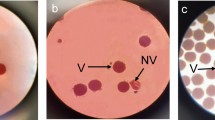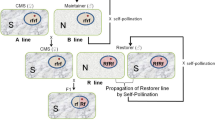Abstract
Apricot (Prunus armeniaca L.) cultivars originated in China display a typical S-RNase-based gametophytic self-incompatibility (GSI). ‘Katy’, a natural self-compatible cultivar belonging to the European ecotype group, was used as a useful material for breeding new cultivars with high frequency of self-compatibility by hybridizing with Chinese native cultivars. In this work, the pollen-S genes (S-haplotype-specific F-box gene, or SFB gene) of ‘Katy’ were first identified as SFB 1 and SFB 8, and the S-genotype was determined as S 1 S 8. Genetic analysis of ‘Katy’ progenies under controlled pollination revealed that the stylar S1-RNase and S8-RNase have a normal function in rejecting wild-type pollen with the same S-haplotype, while the pollen grains carrying either the SFB 1 or the SFB 8 gene are both able to overcome the incompatibility barrier. However, the observed segregation ratios of the S-genotype did not fit the expected ratios under the assumption that the pollen-part mutations are linked to the S-locus. Moreover, alterations in the SFB 1 and SFB 8 genes and pollen-S duplications were not detected. These results indicated that the breakdown of SI in ‘Katy’ occurred in pollen, and other factors not linked to the S-locus, which caused a loss of pollen S-activity. These findings support a hypothesis that modifying factors other than the S-locus are required for GSI in apricot.








Similar content being viewed by others
References
Altschul SF, Gish W, Miller W, Myers EW, Lipman DJ (1990) Basic local alignment search tool. J Mol Biol 215:403–410
Audergon JM, Guerriero R, Monteleone P, Viti R (1999) Contribution to the study of inheritance of the character self-incompatibility in apricot. Acta Hortic 488:275–279
Burgos L, Pérez-Tornero O, Ballester J, Olmos E (1998) Detection and inheritance of stylar ribonucleases associated with incompatibility alleles in apricot. Sex Plant Reprod 11:153–158
Chen XS, Wu Y, Chen MX, He TM, Feng JR, Liang Q, Liu W, Yang HH, Zhang LJ (2006) Inheritance and correlation of self-compatibility and other yield components in the apricot hybrid F1 populations. Euphytica 150:69–74
Entani T, Iwano M, Shiba H, Che FS, Isogai A, Takayama S (2003) Comparative analysis of the self-incompatibility (S-) locus region of Prunus mune: identification of a pollen-expressed F-box gene with allelic diversity. Genes Cells 8:203–213
Feng JR, Cheng XS, Kong N, Shu HR (2006a) Some characteristics associated with self-incompatibility among the Fl progenies in apricot. J Fruit Sci 23:690–694
Feng J, Chen X, Wu Y, Liu W, Liang Q, Zhang L (2006b) Detection and transcript expression of S-RNase gene associated with self-incompatibility in apricot (Prunus armeniaca L.). Mol Biol Rep 33:215–221
Feng JR, Chen XS, Yuan ZH, Zhang LJ, Ci ZJ, Liu XL, Zhang CY (2009) Primary molecular features of self-incompatible and self-compatible F(1) seedling from apricot (Prunus armeniaca L.) Katy × Xinshiji. Mol Biol Rep 36:263–272
Golz JF, Oh HY, Su V, Kusaba M, Newbigin E (2001) Genetic analysis of Nicotiana pollen-part mutants is consistent with the presence of an S-ribonuclease inhibitor at the S locus. Proc Natl Acad Sci USA 98:15372–15376
Halász J, Hegedűs A, Hermán R, Stefanovits-Bányai E, Pedryc A (2005) New self-incompatibility alleles in apricot (Prunus armeniaca L.) revealed by stylar ribonuclease assay and S-PCR analysis. Euphytica 145:57–66
Halász J, Pedryc A, Hegedűs A (2007) Origin and dissemination of the pollen-part mutated Sc haplotype which confers self-compatibility in apricot (Prunus armeniaca). New Phytol 176:792–803
Hershko A, Ciechanover A (1998) The ubiquitin system. Ann Rev Biochem 67:425–479
Huang S, Lee HS, Karunanandaa B, Kao TH (1994) Ribonuclease activity of Petunia infata S proteins is essential for rejection of self-pollen. Plant Cell 6:1021–1028
Huang SX, Wu HQ, Li YR, Wu J, Zhang SJ, Heng W, Zhang SL (2008) Competitive interaction between two functional S-haplotypes confer self-compatibility on tetraploid Chinese pear. Plant Cell Rep 27:1075–1085
Ikeda K, Ushijima K, Yamane H, Tao R, Hauck NR, Sebolt AM, Iezzoni AF (2005) Linkage and physical distances between the S-haplotype S-RNase and SFB genes in sweet cherry. Sex Plant Reprod 17:289–296
Jie Q, Shupeng G, Jixiang Z, Manru G, Huairui S (2005) Identification of self-incompatibility genotypes of apricots (Prunus armeniaca L.) by S-allele-specific PCR analysis. Biotechnol Lett 27:1205–1209
Lai Z, Ma W, Han B, Liang L, Zhang Y, Hong G, Xue Y (2002) An F-box gene linked to the self-incompatibility (S) locus of Antirrhinum is expressed specifically in pollen and tapetum. Plant Mol Biol 50:29–42
Layne REC, Bailey CH, Hough LF (1996) Apricots. In: Janick J, Moore JN (eds) Fruit breeding: tree and tropical fruits, vol 2. Wiley, New York, p 89
Luu DT, Xlike Q, Morse D, Cappadocia M (2000) S-RNase uptake by compatible pollen tubes in gametophytic self-incompatibility. Nature 407:649–651
Marchese A, Bošković RI, Caruso T, Raimondo A, Cutuli M, Tobutt KR (2007) A new self-compatibility haplotype in the sweet cherry ‘Kronio’, S5′, attributable to a pollen-part mutation in the SFB gene. J Exp Bot 58:4347–4356
McClure BA, Haring V, Ebert PR, Anderson MA, Simpson RJ, Sakiyama F, Clarke AE (1989) Style self-incompatibility gene products of Nicotiana alata are ribonucleases. Nature 342:955–957
McClure BA, Cruz-García F, Beecher B, Sulaman W (2000) Factors affecting inter- and intra-specific pollen rejection in Nicotiana. Ann Bot (Lond) 85:113–123
Mehlenbacher SA, Cociu V, Hough LF (1991) Apricots (Prunus). In: Moore JN, Ballington JR (eds) Genetic resources of temperate fruit and nut crops. ISHS, Wageningen, pp 65–107
Okada K, Tonaka N, Moriya Y, Norioka N, Sawanura Y, Matsumoto T, Nakanishi T, Takasaki-Yasuda T (2008) Deletion of a 236 kb region around S4-RNase in a stylar-part mutant S sm 4 -haplotype of Japanese pear. Plant Mol Biol 66:389–400
Qiao H, Wang H, Zhao L, Zhou J, Huang J, Zhang Y, Xue Y (2004) The F-box protein AhSLF-S2 physically interacts with S-RNases that may be inhibited by the ubiquitin/26S proteasome pathway of protein degradation during compatible pollination in Antirrhinum. Plant Cell 16:582–595
Romero C, Vilanova S, Burgos L, Martínez-Calvo J, Vicente M, Llácer G, Badenes ML (2004) Analysis of the S-locus structure in Prunus armeniaca L. identification of S-haplotype specific S-RNase and F-box genes. Plant Mol Biol 56:145–157
Sonneveld T, Robbins TP, Bŏsković R, Tobutt KR (2001) Cloning of six cherry self-incompatibility alleles and development of allele-specific PCR detection. Theor Appl Genet 102:1046–1055
Sonneveld T, Tobutt KR, Vaughan SP, Robbins TP (2005) Loss of pollen-S function in two self-compatible selections of Prunus avium is associated with deletion/mutation of an S haplotype-specific F-box gene. Plant Cell 17:37–51
Stout AB, Chandler C (1941) Change from self-incompatibility to self-compatibility accompanying change from diploidy to tetraploidy. Science 94:118
Tao R, Yamane H, Sugiura A (1999) Molecular typing of S-alleles through identification characterization and cDNA cloning for S-RNases in sweet cherry. J Am Soc Hort Sci 24:224–233
Thompson RD, Uhrig H, Hermsen JGT, Salamini F, Kaufmann H (1991) Investigation of a self-compatible mutation in Solanum tuberosum clones inhibiting S-allele activity in pollen differentially. Mol Gen Genet 226:283–288
Thompson JD, Higgins DG, Gibson TJ (1994) CLUSTALW: improving the sensitivity of progressive multiple sequence alignment through sequence weighting, positions-specific gap penalties and weight matrix choice. Nucleic Acids Res 22:4673–4680
Tsukamoto T, Ando T, Takahashi K, Omori T, Watamabe H, Kokubun H, Marchesi E, Kao TH (2003) Breakdown of self-incompatibility in a natural population of Petunia axillaris caused by loss of pollen function. Plant Physiol 131:1903–1912
Ushijima K, Sassa H, Dandekar AM, Gradziel TM, Tao R, Hirano H (2003) Structural and transcriptional analysis of the self-incompatibility locus of almond: identification of a pollen-expressed F-box gene with haplotype-specific polymorphism. Plant Cell 15:771–781
Ushijima K, Yamane H, Watari A, Kakehi E, Ikeda K, Hauck NR, Iezzoni AF, Tao R (2004) The S haplotype-specific F-box protein gene, SFB, is defective in self-compatible haplotypes of Prunus avium and P. mune. Plant J 39:573–586
Vaughan SP, Russell K, Sargent DJ, Tobutt KR (2005) Isolation of S-locus F-box alleles in Prunus avium and their application in a novel method to determine self-incompatibility genotype. Theor Appl Genet 112:856–866
Vilanova S, Romero C, Burgos L, Llácer G, Badenes ML (2005) Identification of self-(in)compatibility alleles in apricot (Prumus armeniaca L.) by PCR and sequence analysis. J Am Soc Hortic Sci 130:893–898
Vilanova S, Badenes ML, Burgos L, Martínez-Calvo J, Llácer G, Romero C (2006) Self-compatibility of two apricot selections is associated with two pollen-part mutations of different nature. Plant Physiol 142:629–641
Wu Y, Chen X, Feng J, Chen X (2005) Inheritance of S-gene among the F1 progenies in apricot. Acta Hortic Sinica 32:397–402
Wu J, Gu C, Zhang SL, Zhang SJ, Wu HQ, Heng W (2009) Identification of S-haplotype specific S-RNase and SFB genes in native Chinese apricot (Prunus armeniaca L.). J Hortic Sci Biotech 84:645–652
Wünsch A, Hormaza JI (2004) Cloning and characterization of genomic DNA sequences of four self-incompatibility alleles in sweet cherry (Prunus avium L.). Theor Appl Genet 108:299–305
Yamane H, Ikeda K, Ushijima K, Sassa H, Tao R (2003) A pollen-expressed gene for a novel protein with an F-box motif that is very tightly linked to a gene for S-RNase in two species of cherry, Prunus cerasus and P. avium. Plant Cell Physiol 44:764–769
Zhang SL, Yang JG, Li XG, Hiratsuka S, Wolukau JN (2002) Differences of S-glycoprotein content in the styles among pear cultivars differing in self-incompatible strength. Acta Hortic Sinica 29:165–167
Zhang SL, Huang SX, Kitashiba H (2007) Identification of S-haplotype-specific F-box gene in Japanese plum (Prunus salicina LindI.). Sex Plant Reprod 20:1–8
Zhang LJ, Chen XS, Chen XL, Zhang CY, Liu XL, Ci ZJ, Zhang H, Wu CJ, Liu CQ (2008) Identification of self-incompatibility (S-) genotypes of Chinese apricot cultivars. Euphytica 160:241–248
Author information
Authors and Affiliations
Corresponding author
Additional information
Communicated by Teh-hui Kao.
Rights and permissions
About this article
Cite this article
Wu, J., Gu, C., Du, YH. et al. Self-compatibility of ‘Katy’ apricot (Prunus armeniaca L.) is associated with pollen-part mutations. Sex Plant Reprod 24, 23–35 (2011). https://doi.org/10.1007/s00497-010-0148-6
Received:
Accepted:
Published:
Issue Date:
DOI: https://doi.org/10.1007/s00497-010-0148-6




